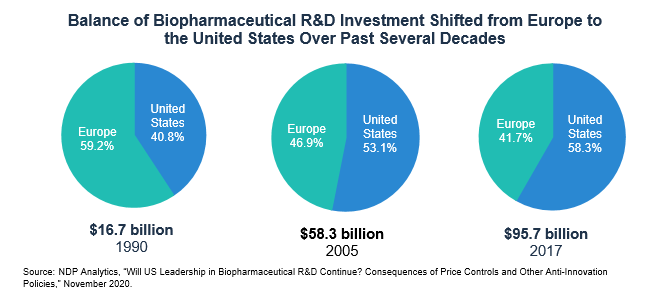Today, America leads the world in medical innovation because of our unique research ecosystem, but that wasn’t always the case. A new paper from NDP Analytics, “Will US Leadership in Biopharmaceutical R&D Continue? Consequences of Price Controls and Other Anti-Innovation Policies,” takes a look at the positive and negative impacts that public policies can have on biopharmaceutical innovation – namely how the adoption of government price setting and other anti-innovation policies across Europe in the 1980s and 1990s pushed the locus of R&D investment away from the continent to countries with more pro-innovation policies, principally the United States.
- In the 1980s and early 1990s: Europe led the world in biopharmaceutical innovation. As the paper notes, “In 1990, biopharmaceutical R&D investment in Europe was over 45% higher than similar investment in the United States.” However, major countries in Europe began implementing stringent price setting and other anti-innovation policies at this time.
- In the mid to late 1990s: Impacts from the adoption of these anti-innovation policies in Europe began to be felt. While European governments pursued policies that discouraged investment in R&D, the United States maintained pro-innovation intellectual property protection and market-based pricing policies.
- In the late 1990s to early 2000s: The United States became the global leader in biopharmaceutical innovation as the total amount of biopharmaceutical R&D investment in the United States surpassed Europe. The United States remains the global leader today.

Government price setting policies may have different names and mechanisms, but all give bureaucrats control over our medicines and threaten access to treatments and cures. Recently, a number of U.S. politicians have considered a form of government price setting known as international reference pricing in which U.S. bureaucrats would determine the value of our medicines based on how foreign governments and politicians value these treatments and cures. Taking a look back at Europe’s experience shows just what is at stake if policymakers take America’s global R&D leadership for granted and proceed with government price setting proposals.
In fact, history could repeat itself if we don’t learn from it. Today, while U.S. policymakers are considering archaic anti-innovation price setting policies, some Asian countries are increasingly adopting public policies more supportive of innovation. According to findings in the new paper, “Biopharmaceutical R&D investment in Asia increased 45.0% from $14.7 billion in 2008 to $21.3 billion 2016, compared to 34.3% in the U.S. during the same period.”
The lesson from history is clear: Government price setting and other anti-innovation policies discourage R&D investment, threatening the jobs and other economic outputs – including a significant advanced manufacturing presence – that come from a robust biopharmaceutical research industry.
U.S. policymakers should abandon government price setting proposals and instead pursue policies that support America’s continued global leadership in biopharmaceutical innovation.






